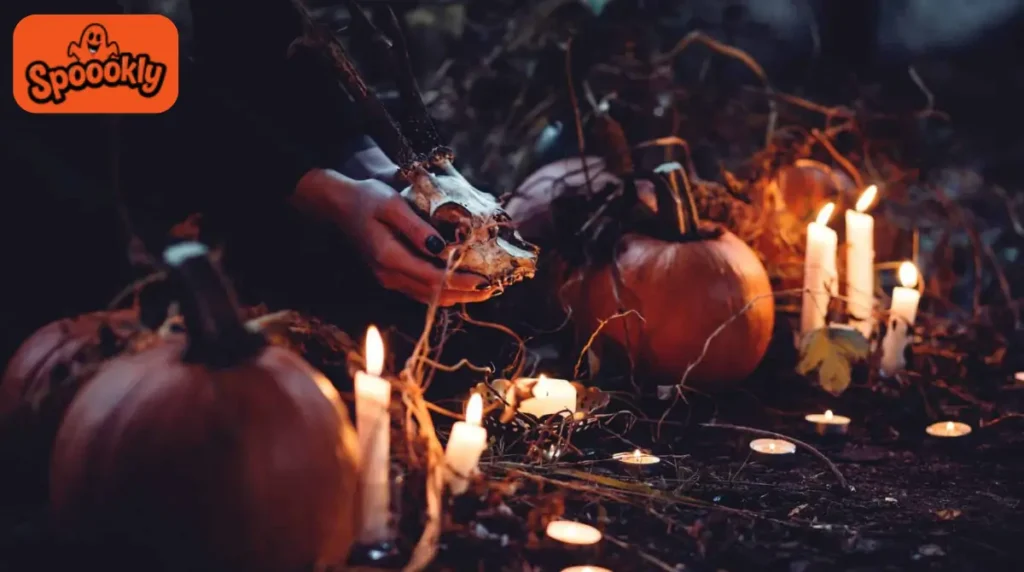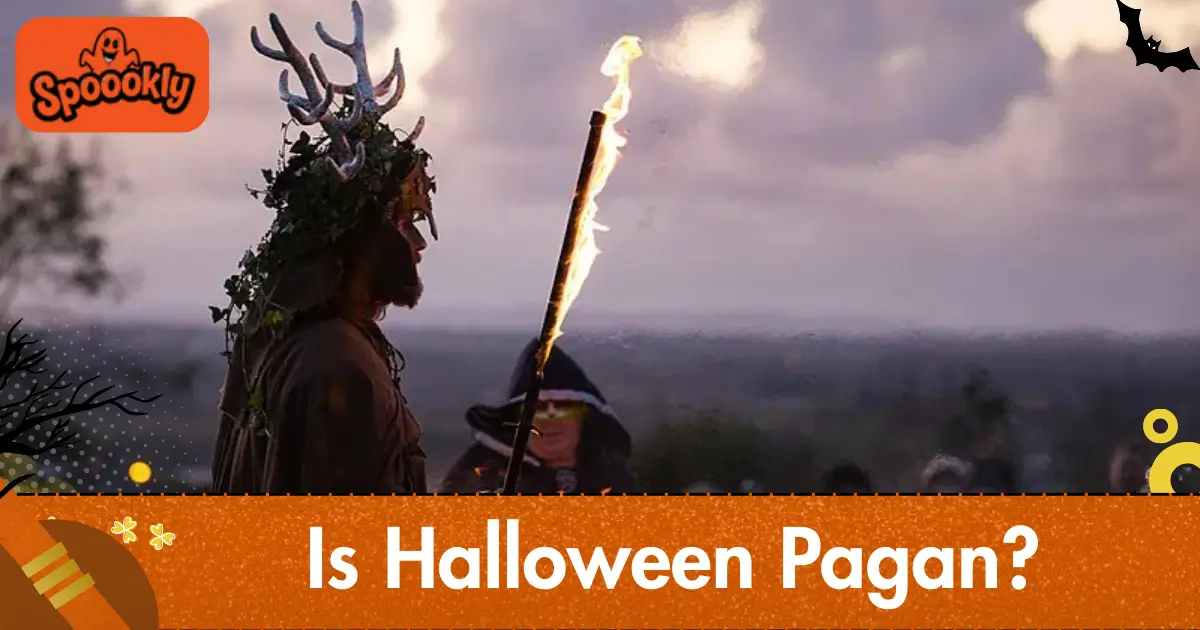Halloween does have pagan roots. The earliest customs trace back to the Celtic festival of Samhain, a Gaelic pagan tradition marking the end of harvest and the start of winter.
Over centuries, Christianity layered new meanings onto this day, turning it into All Hallows’ Eve, the vigil before All Saints’ Day.
Today, Halloween is a mix of pagan symbolism, Christian practices, and modern secular fun.
So, calling it “pagan” alone oversimplifies things. It is more accurate to call Halloween a syncretic holiday blended from multiple traditions.
What Does “Pagan” Really Mean?
Classical meaning of “pagan”
The word pagan originally described people in ancient Europe who practiced polytheistic religions. They honored nature, seasons, and multiple gods, often tied to agriculture and the cycles of life.
Modern meaning of “pagan”
Today, “pagan” may refer to Neopagan movements, like Wicca, or people reviving folk traditions.
It can also be used loosely to mean anything “non-Christian.”
Why this matters for Halloween
When people ask if Halloween is pagan, it depends on which definition they use.
If they mean origins, then yes, the holiday clearly reflects Samhain’s influence.
If they mean current religious practice, then no, most Halloween celebrations today are not pagan rituals.
The Ancient Roots of Halloween – Samhain
What was Samhain?
Samhain (pronounced “sow-in”) was celebrated by Celtic communities in Ireland and Scotland around October 31 to November 1.
It marked the end of the harvest season and the beginning of winter, sometimes called the “darker half” of the year.
People believed this was a liminal time, when the veil between the living and the dead grew thin.
Spirits were thought to roam freely, and people honored ancestors or tried to protect themselves from harmful entities.
Rituals and customs of Samhain
- Bonfires: Huge fires were lit to ward off evil and provide light during longer nights.
- Offerings: Food and drink were left outside for visiting spirits.
- Disguises: People wore masks or costumes to confuse wandering spirits.
- Divination: Practices like reading fortunes were common, as people sought guidance for the hard winter ahead.
The idea that Halloween is about ghosts, costumes, and supernatural encounters connects strongly to these Samhain traditions.
Quick Facts
| Tradition | Time | Purpose | Practices |
|---|---|---|---|
| Samhain (Pagan Celtic) | Oct 31 – Nov 1 | End of harvest, honor dead, protect from spirits | Bonfires, offerings, disguises, divination |
| All Hallows’ Eve (Christian) | Oct 31 | Vigil before All Saints’ Day | Masses, prayers, “souling,” church vigils |
| Modern Halloween (Secular) | Oct 31 | Community fun, costumes, candy, horror themes | Trick-or-treating, parties, haunted houses |
Christian Adaptation Begins
By the 7th century, the Church established All Saints’ Day to honor saints and martyrs.
Later, the date was fixed on November 1, and the night before became All Hallows’ Eve.
This was not random. Many historians believe the Church aligned this feast with Samhain to help people transition from pagan practices to Christian observance.
Instead of bonfires and offerings, Christians attended vigils, rang bells, and prayed for the dead.
This blending is why Halloween is neither purely pagan nor purely Christian, it grew from both streams.
Christian Adaptation & All Hallows’ Eve
Why the Church set November 1 as All Saints’ Day
By the early Middle Ages, the Church wanted to honor saints and martyrs with a dedicated feast.
In the 9th century, November 1 was chosen as All Saints’ Day, and October 31 became All Hallows’ Eve.
Scholars suggest this was strategic. Placing it beside Samhain helped convert Celtic people, replacing their festivals with Christian ones.
How Christian practices blended with folk customs
Christian worship didn’t erase local customs entirely. Instead, they merged.
- Souling: People went door-to-door, offering prayers for the dead in exchange for “soul cakes.”
- Church vigils: Masses, fasting, and prayers were held to honor the departed.
- Bells & candles: These were used to guide souls and ward off evil.
At the same time, older practices like dressing up or telling ghost stories survived. They just took on new Christian or cultural meanings.
Halloween Today – Pagan, Christian, or Secular?
Modern expressions of Halloween
Walk through any neighborhood on October 31, and you’ll see costumes, pumpkins, haunted houses, and kids filling buckets with candy.
Halloween today is largely secular and commercial, with billions spent on decorations, candy, and events.
Residual pagan symbolism
Still, many features echo pagan beliefs:
- Ghosts and spirits reflect Samhain’s idea of the thinning veil.
- Bonfires and lanterns recall fire rituals.
- Masks and disguises connect to guising traditions.
Even if people no longer view them as religious, these symbols carry ancient echoes.
Christian perspectives on Halloween
- Some Christians see Halloween as harmless cultural fun or even a chance to remember saints and the dead.
- Others reject it, citing its associations with occult practices, ghosts, and witchcraft.
This divide explains why some churches host Harvest Festivals or All Saints’ alternatives instead.
Pagan and Neopagan observance
Meanwhile, many modern pagans and Wiccans observe Samhain on October 31.
For them, it’s a spiritual festival to honor ancestors and reflect on cycles of life and death.
This is different from secular Halloween, though the two share similar imagery.

Arguments For & Against Labeling Halloween as Pagan
Arguments supporting “Halloween is pagan”
- Halloween has a direct link to Samhain in both date and theme.
- Traditions like costumes, honoring the dead, and spirit lore trace back to pagan roots.
- Cultural historians note the strong influence of Celtic beliefs.
Arguments against calling it purely pagan
- Christianity reshaped the holiday, adding new practices like souling and vigils.
- Most people celebrate Halloween today with no religious intent just candy and fun.
- Its commercial, secular character makes it far removed from a pagan ritual.
Middle ground: a syncretic holiday
The most accurate description is that Halloween is syncretic, a mix of traditions.
It carries pagan roots, Christian overlays, and modern cultural layers.
Cultural Impact & Global Variations
Religious and ethical debates
- Some churches view Halloween as harmless cultural play.
- Others warn against its supernatural themes, suggesting alternatives.
- For pagans, Samhain is spiritual, not commercial.
- For secular families, it’s costumes, candy, and community fun.
Cultural impact
Halloween sparks debates every year whether it promotes superstition, whether it’s “pagan,” or whether it’s simply a community event.
Either way, it has become a major cultural event in the U.S. and beyond.
Global variations
- Mexico: Día de los Muertos (Day of the Dead) shares themes of honoring the departed but is distinct.
- Ireland & Scotland: Old Samhain customs still echo in Halloween festivals.
- Japan & Singapore: Urban Halloween parades have emerged in recent years.
- Other countries: Some celebrate it lightly, while others resist it as foreign or too commercial.
Halloween’s spread shows it’s more than just a pagan or Christian holiday, it’s a global cultural export.
Implications & Relevance of Halloween’s Roots
For Christians
For Christians, the question “is Halloween pagan” often comes down to personal conviction.
Some embrace it as a cultural event or even as part of All Hallows’ Eve traditions.
Others avoid it due to its occult symbols.
Both views stem from a desire to honor faith, but the decision varies by community.
For Pagans and Neopagans
For modern pagans, Halloween is less important than Samhain itself.
Samhain is seen as a spiritual observance, focused on ancestors and nature cycles.
While Halloween shares imagery, it is often viewed as a secular shadow of Samhain.
For Secular Families
For most people today, Halloween is simply about fun, costumes, and candy.
Its pagan and Christian roots are rarely considered in modern neighborhoods.
Instead, it is valued as a community holiday, a chance to decorate, celebrate, and connect.
Cultural Impact & Contemporary Debates
Halloween continues to spark religious, ethical, and cultural debates.
- Some schools and churches replace it with Harvest Festivals.
- Others host trunk-or-treat events as a safer alternative.
- Global spread raises questions: Is it cultural exchange or cultural dominance?
Either way, Halloween has become a worldwide phenomenon, carrying echoes of its ancient and Christian past while thriving as a secular celebration.
Conclusion
So, is Halloween pagan?
The short answer is yes, its roots are in the Celtic pagan festival of Samhain.
But it didn’t stay there. Over centuries, Christian traditions layered onto it, and modern society transformed it into the Halloween we know today.
That’s why calling Halloween “pagan” alone is too simplistic.
It’s better understood as a hybrid holiday, shaped by pagan, Christian, and secular influences.
Whether you see it as a spiritual day, a cultural event, or just a night for costumes and candy, Halloween has one thing in common across all traditions: it brings people together in the face of the changing season.
And maybe that’s the real magic of October 31.
FAQs
No. Pagans didn’t celebrate “Halloween.”
They celebrated Samhain, a festival marking the end of harvest and the thinning veil between worlds.
Halloween became widely secular in the 20th century, especially in North America. Commercialization and candy companies turned it into a fun community event.
Many symbols like ghosts, bonfires, disguises, spirits come from pagan Samhain. Others, like pumpkins and trick-or-treating, developed later.
Some Christians do, seeing it as cultural. Others don’t, due to concerns about the occult. There is no single answer, it depends on personal and denominational views.
Pagans mark Samhain with rituals honoring ancestors, meditation, and seasonal rites. Halloween, by contrast, is mostly costumes and candy with little religious meaning.

